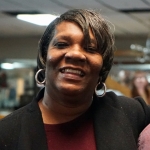
Ms. Amina Cooper
How Public Art Programs Can Join the Movement Against Police Brutality, White Supremacy, and Anti-Black Racism
Posted by Jun 10, 2020

Ms. Amina Cooper
On May 25, 2020, Minnesota police officer Derek Chauvin brutally murdered George Floyd, an unarmed Black father accused of issuing a counterfeit $20 bill, while other police officers stood by. This tragedy, following many other recent police-involved shootings of unarmed Black men and women that have been broadcasted and protested nationwide, has sparked renewed and global visibility for the Black Lives Matter movement. This most recent wave of protests has prompted a discussion within the public art field: How can public art respond to the Black Lives Matters movement? Should it? What will we do about the public artwork that is being tagged and damaged during these protests? Public art, at its best, is an authentic reflection of our times and values. Public art should reflect the community around it, and represent the hopes, lives, and aspirations of the people in that community. What we can do as public art policy makers and administrators is uplift those voices in our communities that are calling for justice and equal protection for people of color under the law. It is time to talk about the lack of diversity within our public art commissions, artist selection panels, and our public art workforce. We need to address the elitism with which we dictate to communities which artworks are acceptable, and which persons and cultures are worth affirming with monuments and beautiful objects.
Read More






























